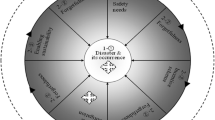Abstract
Narrative approaches to analyzing risks seek to identify the variables critical to creating and controlling a risk, then to instantiate them in terms of coherent themes (e.g., organizational failure, strategic surprise). Computational approaches to analyzing risks seek to identify the same critical variables, then to instantiate them in terms of their probability. Disaster risk analysis faces complex, novel processes that strain the capabilities of both approaches. We propose an approach that integrates elements of each, relying on what we call structured scenarios and computable models. It is illustrated by framing the analysis of plans for a possible avian flu pandemic.
Similar content being viewed by others
References
Brown, Rex.V. (2005). Rational Choice and Judgment: Decision Analysis for the Decider. Hoboken, NJ: Wiley.
Bruine de Bruin, Wändi, Baruch Fischhoff, Larry Brilliant and Denise Caruso. (2006). “Expert Judgments of Pandemic Influenza,” Global Public Health 1(2), 1–16.
Burns, William J. and Robert T. Clemen. (1993). “Covariance Structure Models and Influence Diagrams,” Management Science 39, 816–834.
Casman, Elizabeth et al. (2001). “Climate Change and Cryptosporidiosis. A Qualitatitive Analysis,” Climate Change 50, 219–249.
Clemen, Robert. (1997). Making Hard Decisions. Belmont, CA: Duxbury.
Crouch, Edmund and Richard Wilson. (1981). Risk Benefit Analysis. Cambridge: Harvard University Press.
Department of Health and Human Services. (2006). Pandemic Planning Update. Washington, DC: Department of Health and Human Services.
Dombroski, Matthew, Baruch Fischhoff and Paul Fischbeck. (in press). “Predicting Emergency Evacuation and Sheltering Behavior.” Risk Analysis.
Downs, Julie S. et al. (2004). “An Interactive Video Program to Reduce Adolescent Females’ STD Risk: A Randomized Controlled Trial.” Social Science and Medicine 59, 1561–1572.
Eggers, Sara L. and Baruch Fischhoff. (2004). “A Defensible Claim? Behaviorally Realistic Evaluation Standards,” Journal of Public Policy and Marketing 23, 14–27.
Fischhoff, Baruch. (2000). “Scientific Management of Science?” Policy Sciences 33, 73–87.
Fischhoff, Baruch. (2005). “Decision Research Strategies,” Health Psychology 21(4), S9–S16.
Fischhoff, Baruch, Julie S. Downs and Wändi Bruine de Bruin. (1998). “Adolescent Vulnerability: A Framework for Behavioral Interventions,” Applied and Preventive Psychology 7, 77–94.
Fischhoff, Baruch et al. (1981). Acceptable Risk. New York: Cambridge University Press.
Fischhoff, Baruch et al. (2003). “Evaluating the Success of Terror Risk Communication,” Biosecurity and Bioterrorism: Biodefense Strategy, Practice, and Science 1(4), 255–258.
Fox, Maggie. (2006, May 9). “Experts Fear Bird Flu Movie May Spur Panic,” Reuters.
Funtowicz, Sylvio and Jeremy Ravetz. (1990). Uncertainty and Quality in Science for Policy. Dordrecht: Kluwer.
GÜvenç, ümit. (2005). A Scenario-based Risk Assessment and Risk Communication Methodology for a New Biomedical Technology. Carnegie Mellon University. Unpublished dissertation.
Harris, Gardiner. (2005, September 14). “From Washington, a Story about a Killer Flu,” New York Times.
Institute of Medicine. (2006). Reusability of Facemasks During an Influenza Pandemic. Washington, DC: National Academy Press.
Kaufmann, Arnold F., Martin I. Meltzer and George P Schmid. (1997). “The Economic Impact of a Bioterrorist Attack: Are Preventional and Post-attack Intervention Programs Justifiable?” Emerging Infectious Disease 3(2), 83–94.
Krayer von Krauss, Martin P. Elizabeth Casman and Mitchell J. Small. (2004). “Elicitation of Expert Judgments of Uncertainty in the Risk Assessment of Herbicide-tolerant Oilseed Crops,” Risk Analysis 24, 1515–1527.
Krishnamurti, Tamar P., Sara L. Eggers and Baruch Fischhoff. (2006). “A Behavioral Decision Approach to Regulatory Law: An Application to Teens’ Contraceptive Decision-making Competence,” Under editorial review.
Levi, Michael A. and Henry C. Kelly. (2002, November). “Weapons of Mass Disruption,” Scientific American 77–81.
Morgan, M.G. et al. (2001). Risk Communication: The Mental Models Approach. New York: Cambridge University Press.
Morgan. M. Granger and Max Henrion. (1990). Uncertainty. New York. Cambridge University Press.
Morgan, M. Granger and David W. Keith. (1995). “Subjective Judgments by Climate Experts,” Environmental Science and Technology 29, 468A–476A.
National Research Council. (1996). Understanding Risk. Washington: National Academy Press.
Salaam-Blyther, Tiaji and Emma Chanlett-Avery. (2006). US and International Responses to the Global Spread of Avian Flu. Washington, DC: Congressional Research Service.
Schwartz, Peter. (1991). The Art of the Long View. New York: Doubleday.
Viscusi, W. Kip and Joseph E. Aldy. (2003). “Value of Statistical Life: A Critical Review of Market Estimates Throughout the World,” Journal of Risk and Uncertainty 21, 5–76.
Wessely, Simon. (2005). “Don’t Panic! Short and Long-term Psychological Reactions to the New Terrorism,” Journal of Mental Health 14, 1–6.
WHO. (2005). Mental Health of Populations Exposed to Biological and Chemical Weapons. Geneva: World Health Organization.
Zamiska, Nicholas. (2006, January 13). “Antiflu-drug Handout in China Alarms Health Experts,” Wall Street Journal, p. A9.
Author information
Authors and Affiliations
Corresponding author
Additional information
JEL Classification H89 · I1 · O21
Rights and permissions
About this article
Cite this article
Fischhoff, B., de Bruin, W.B., Güvenç, Ü. et al. Analyzing disaster risks and plans: An avian flu example. J Risk Uncertainty 33, 131–149 (2006). https://doi.org/10.1007/s11166-006-0175-8
Issue Date:
DOI: https://doi.org/10.1007/s11166-006-0175-8




